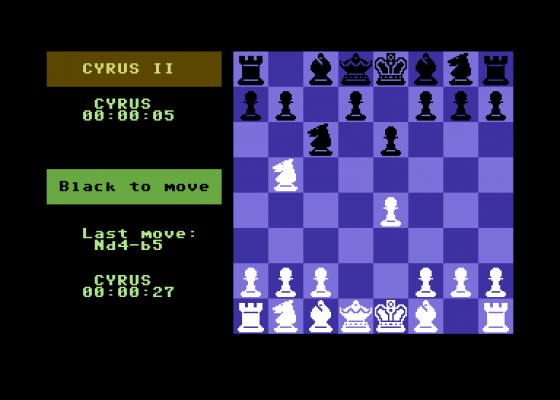Cyrus II Chess
Cyrus II has been around on various machine formats for over eighteen months. It has clocked up an impressive sales figure of 70,000, making it one of the most successful microcomputer chess programs. The program has now been converted for the Commodore, and though it has lost some of its more attractive "extras" in the process, it is nevertheless a long overdue and valuable addition to the Commodore's group of chess programs.
Cyrus II is a nine level chess program, designed with features to benefit players of all abilities. A novice can begin at the lowest level, and gradually work his way up to level nine as his skills and experience increase. The beauty of this particular multi-level format is that there is an element of challenge present even at the lowest level - essentially, only the computer's methods change throughout.
Pieces are moved by either cursor control or co-ordinate entry methods - co-ordinates are only displayed by the board if the latter function is in use. The two-dimensional board is displayed to the right of the screen, with the left side containing information relevant to the current game. Other information is contained in the menu, which can be accessed by pressing the space bar.

I found some of the contents of Cyrus' extensive menu to the particularly useful. Most notable of these is the 'hint' feature, brought into action by the H key. During the computer's move this can be used to show the move which it is currently considering. During your move, Cyrus gives you a hint as to what you might consider - though this is not necessarily the best move available.
When a game is aborted and a new game started, an on-screen message appears asking you to confirm this decision, reducing the risk of accidentally ending a game. Pressing M during your move allows you to swap sides - performing the same action during Cyrus' move causes the computer to execute its best move immediately. If you do decide to change sides, you may want to invert the board. This is carried out by pressing I. It is also possible to play both sides yourself, or to allow Cyrus the same privilege.
Pressing B retracts a move and allows you to move again. This operation can be carried out in any situation, including Check and Checkmate.

This version of Cyrus II is unfortunately lacking some of the features available on other formats. It's a pity that the Save/Load option isn't included, as it is often useful if a game carries on for a particularly long time (this can happen quite frequently on the higher levels). Also missing is the 3D display option, and though this is purely cosmetic it does add an extra touch of realism - I for one am sorry that it's gone.
If you are looking for a challenging and enjoyable chess program, no matter what your ability, Cyrus II will undoubtedly meet your requirements.
Better still, Alligata Software have an interesting trade-in offer for Cyrus II. If you already own a chess program, but are interested in getting your hands on Cyrus II, simply send your old program with a cheque or postal order for £6.95 to: Alligata Software Ltd, Orange Street, Sheffield S1 4DW. They will send you a brand new copy of Cyrus II. (Don't forget to state cassette or disk when placing your order.) If however, you are not entirely satisfied with the performance of Cyrus II, Alligata will refund your money and your old program!
Lee Paddon
Cyrus II shares most of the strengths and weaknesses of its competitors. It has a good book of openings, including some fairly obscure variations which will have even the expert racking his brains. The middle-game is fairly strong, but the program lacks an overall sense of 'vision' - it often fails to recognise the current local point of the game, and goes off on a complete tangent. Like all chess games, where Cyrus II really falls apart is the end game. If you ever feel like beating a chess program, just swap off everything in sight and watch it struggle. This is because in the end game, patterns of pieces are more important that analysing series of moves, which is what the computer is programmed to do. The lack of feel in the middle game makes it a better attacker than defender, but it will rarely put together a dazzling mating combination - just win a pawn here and a piece there and grind you to death.
Despite all this criticism, Cyrus II is one of the fastest and strongest chess programs I have come across. It can often produce an exciting, enjoyable game, and you can always accidentally pull the plug out if you're losing - the computer equivalent of tipping the board over.


 1st March 1987
1st March 1987




